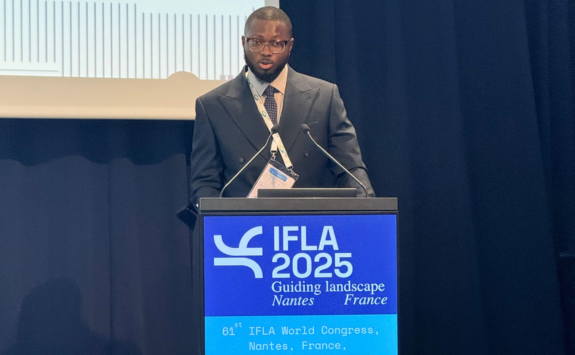Meet the Class of 2024 architect planning to build a better future
This World Architecture Day, we’re shining a light on recent international graduate Precious Ovat, whose time on campus has transformed his practice as a landscape architect and inspired research recently presented on a global stage.
6 October 2025
Happy World Architecture Day!
To celebrate World Architecture Day (6 October), we spoke with recent graduate Precious Ovat (MA Landscape Architecture, 2024) about his experience at Newcastle University, the role of architecture in creating a positive impact on the world, and his Newcastle-inspired research, which was recently featured at the 61st World Congress of the International Federation of Landscape Architects.

Hi Precious! Tell us how you first fell in love with architecture.
From an early age, I was introduced to architecture through my father's practice. It was there that I first saw how sketches and drawings could transform imagination into reality. I began by tracing his lines and creating my own sketches, and this early curiosity soon developed into a strong belief that design is a means of shaping how people experience the world and not just a profession.
Studying architecture gave me the opportunity to transform that early passion into skill, but it also expanded my ambition. I found real fulfilment in designing spaces that serve both as a function and an atmosphere that creates identity and meaning. Each project encouraged me to think about how buildings can enhance lives, generate unique experiences, and have a positive impact on the world.
As a post-industrial city, Newcastle embodies many of the critical challenges and opportunities facing architecture and landscape architecture today. So, for me, Newcastle was not only a place to study but a living test bed where I could draw inspiration that can inform my practice at a global scale.
Today, my aspiration goes beyond simply designing buildings. I want to create architecture and landscapes that respond to challenges like climate change, urbanisation, affordable housing, digital innovation, and social justice. My goal is to leave a lasting footprint in the sands of time by creating smart cities and places that embody sustainability and human connection.
My goal is to leave a lasting footprint in the sands of time by creating smart cities and places that embody sustainability and human connection.
What were your student days like?
I have so many treasured memories from my time at Newcastle University. Among the highlights were the field trips organised by the School of Architecture, Planning and Landscape. Visiting the Sycamore Gap in October 2022 and walking along the ruins of Hadrian’s Wall gave me a profound sense of history and appreciation for the landscape. And our trip to Holy Island in May 2023 combined cultural discovery with the breathtaking scenery of the North East coast.
Beyond my studies, Newcastle University shaped my personal life in unforgettable ways. It was here that I met my soulmate, who also studied at Newcastle, and our journey together has been life-changing, growing from friendship into marriage. I also had the opportunity to work part-time at St. James’ Park, which meant experiencing Newcastle United matches firsthand and being part of the city’s vibrant football culture.
As an international student from Nigeria, I had to balance my academic commitments with multiple part-time jobs to meet tuition and living costs during the cost-of-living crisis in England. While this limited my ability to join formal societies, it also taught me resilience, discipline, and how to manage competing priorities, skills that continue to shape my professional life.


Tell us about your practice as an architect.
My time at Newcastle profoundly shaped the way I think and practice as an architect. As a post-industrial city, Newcastle presents both opportunities and challenges: the legacy of industrialisation has left contaminated soils, many brownfield sites, and a rich stock of listed buildings. Engaging with this complex landscape sharpened my critical thinking and taught me to see design not only as a response to problems, but as a way of transforming constraints into opportunities.
During my MLA, I developed a design thesis that reimagined a brownfield site in Gateshead as a play park to address antisocial behaviour and improve social cohesion. I also drew inspiration from Newcastle’s landscape for my research on modelling European industrial cities through native ecosystems and digital innovation, which I recently presented at the 61st IFLA World Congress in Nantes. Working in such a context has also deepened my appreciation for heritage and adaptive reuse. Newcastle’s abundance of listed buildings has pushed me to explore how renovation and innovation can coexist, preserving cultural identity while shaping resilient urban futures.
My time at Newcastle profoundly shaped the way I think and practice as an architect.
What are the biggest challenges facing the world today that architects can help solve?
The world is facing issues of affordable housing, climate change, biodiversity loss, and the rehabilitation of dilapidated structures and post-industrial landscapes. Through projects like my Gateshead play park thesis and my research presented at the IFLA World Congress, I have proven that architecture and landscape architecture can transform ecological damage into opportunities for resilience and community wellbeing. Yet I recognise that the responsibility of architects extends even further. The future will demand solutions to water scarcity, energy transition, waste reduction, and the creation of cooler, healthier cities in the face of rising global temperatures. It will require creating inclusive spaces for aging populations and developing frameworks for communities displaced by conflict or climate migration.
At the same time, the digital revolution presents new responsibilities: ensuring that smart cities, AI, and data-driven design serve all communities equitably, while preserving cultural identity and resisting homogenisation. Architecture will also continue to play a vital role in post-disaster recovery and even in preparing humanity for life in extreme environments. My ambition is to contribute to these global frontiers by using digital innovation to design structures, landscapes and cities that are not only sustainable, but also inclusive, and inspiring for generations to come.
Architecture and landscape architecture can transform ecological damage into opportunities for resilience and community wellbeing.
You recently presented your research at the 61st World Congress of the International Federation of Landscape Architects in Nantes. What was that experience like?
Receiving the invitation to present at the IFLA World Congress was a defining moment in my career. It’s the most important gathering of landscape professionals in Europe, and so I was very excited to share my work on a global stage.
I presented a paper titled “From Grey to Green: Modelling European Industrial Cities through Native Ecosystems and Digital Landscape Innovations”. This research was inspired by my stay in Newcastle, where the legacies of industrialisation are still present in its landscapes. I wanted to explore how these challenges could be reimagined as opportunities, so my study investigated whether native ecosystems and digital innovations could redefine the affected landscapes. I discussed how Artificial intelligence is used in many sectors, and how it could be applied to landscape architecture. This area deeply excites me because I see digital innovation, particularly AI, as a frontier that will radically transform both architecture and landscape architecture. My ambition is to expand this line of research, exploring new ways that technology can help us design sustainable and smart cities.
Attending the World Congress has changed my perspective on how landscapes, design, and materiality should be approached. Nantes, with its rich landscape and ongoing urban development, was an inspiring setting to see innovative technology and design techniques. Hearing from global industry leaders gave me new insights into the profession’s responsibilities. I learned that while we must reuse materials and recycle land, we must also respect the culture and identity of each site, because every landscape is unique to its context.
I left the conference with a deeper conviction that while beauty in landscapes is often taken for granted, its absence is always felt, so we need to design for both beauty and resilience.

You only graduated from Newcastle University last year and you have already achieved so much! Where do you see yourself in five years?
In five years, I hope to be recognised as a leading voice in sustainable architecture and landscape architecture, with chartered status in both the Landscape Institute and the RIBA. By then, I aim to have expanded my professional associations across Africa, Europe, and America, contributing to the advancement of the discipline on multiple continents. I hope to see the proposals I have begun in Africa take shape, while also contributing to innovative architectural and landscape practice in Europe and America.
I want to inspire young professionals, encouraging the next generation to see design as a tool for planetary health and social justice.
Mentorship is particularly important to me, and I want to inspire and guide young professionals, increasing the visibility of landscape architecture worldwide and encouraging the next generation to see design as a tool for planetary health and social justice.
My vision is to work as a senior architect or landscape architect within a renowned international firm, while also pursuing independent commissions that allow me to innovate and experiment as a self-employed designer.
That sounds really exciting! Thanks for speaking with us, Precious.
Do you have news to share with our alumni community?
Get in touch and share your latest news and achievements so we can let your fellow Newcastle alumni know!
